
Don’t judge a book by its cover, but by its endpaper. Found at the beginning and end of a hardcover book, endpapers serve both functional and aesthetic purposes. Whether plain, patterned, or illustrated, they help bind the book block to the book cover and provide the first visual impression a reader experiences beside the cover. Despite their subtle role, they can hint at themes or convey information about the author, so let’s dive further into this subject.
Inhaltsverzeichnis
Definition: Endpaper
In bookbinding, endpapers — also known as endsheets or endleaves — are a book’s first and last sheets made from a single sheet of double-size paper folded once. This folded sheet is then glued to the inside cover of a hardcover book to conceal the raw paperboard.
They can be used for aesthetic purposes and also help reinforce the book’s entire structure since a book block is too heavy to be glued directly to the cover. Therefore, endsheets can be used to add a creative or utilitarian touch to the book. So, in this article, let’s stop judging books by their covers and start judging them by their endpapers instead.
Benefits
Although endpapers might seem like a small detail, they offer a range of benefits. Here are some of the key benefits of endsheets:
- Structural support: First and foremost, endpapers help bind the book block to the hardbound cover, which ensures the book holds together and withstands frequent handling.
- Setting the tone: Endpapers can reflect the book’s theme or genre, e.g., parts of a map in a story set in a fictional world, creating an immediate connection with the reader.
- Creative expression: Designers use endpapers as a space for artistic touches, such as artwork or patterns, that can enhance the visual storytelling or simply contribute to the overall design of the book.
- Enhancing collectability: In collectible editions or limited runs, unique or luxurious endpapers can add value to books, which makes them feel even more special and one-of-a-kind.
Hardcover with individual embossing
- Price calculator & 3D live preview
- Professional binding for thesis, dissertation, or books
- Print on demand with fast delivery right to your doorstep
Learn more!
How many pages?
In hardcover bookbinding, you can choose between 2-page, 4-page, or 8-page endpapers. Each one will be explained below with additional images.
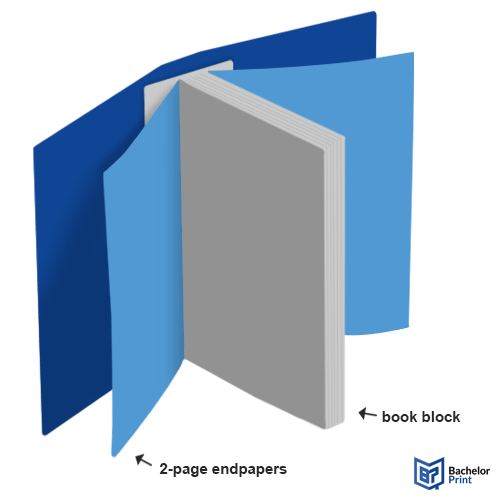
2-page endpaper
A 2-page endpaper consists of a single, unfolded sheet of paper that serves as both the pastedown and the connection to the book block. Page one — the front side — is fully pasted down to the inside of the book cover and is visible when the book is first opened. Page two — the back side — is adhered directly to the first or last page of the book block, typically along the book spine.
This method is rarely used in traditional bookbinding but is typically found in on-demand or short-run hardcover production, where cost-efficiency is prioritized. It doesn’t include a flyleaf; therefore, it offers minimal structural support and is reserved for thinner publications. This can be improved by gluing a piece of cloth (e.g., mull) over the spine and extending it onto the endpapers.
4-page endpaper
A 4-page endpaper is made from a single sheet of paper folded once into a folio, creating four pages (two leaves). This is the most commonly used format in both traditional hand bookbinding and commercial hardcover production. The front side of page one (the pastedown) and the back of page four are both adhered to the inside covers, while the inner pages act as flyleaves that sit between the cover and the book’s text block.
This structure provides a buffer between the cover and the text, which not only improves flexibility but also adds a layer of protection for the interior pages. The flyleaves can be printed on for aesthetic purposes or with the author’s information.
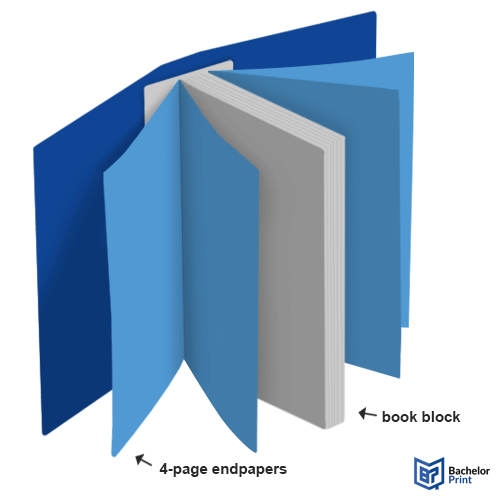
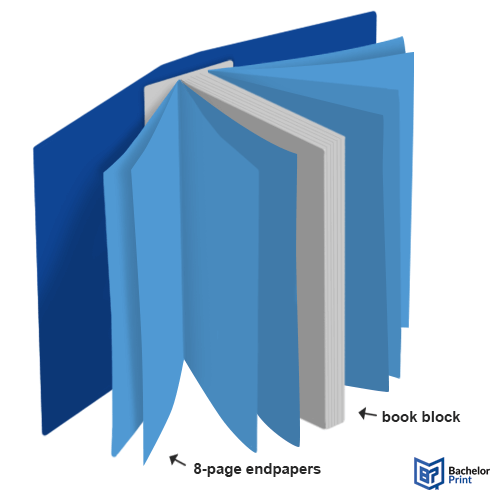
8-page endpaper
An 8-page endpaper consists of four folios that are nested together to create eight pages. This endpaper unit may be sewn into the book block like a regular signature or attached using other methods, depending on the binding style. The additional pages offer even more design space, e.g., for artwork, maps.
This format is typically used in deluxe, illustrated, or special editions, where added visual impact is desired. The 8-page structure can also help balance out imposition in book design or create a more substantial transition between the cover and the content.
In the table below, you can find the explanations for specific bookbinding terms mentioned previously.
| Pastedown | The part of the endpaper that is glued to the inside of the cover to conceal the raw board and help attach the book block to the case. |
| Flyleaf | The free, unglued page of the endpaper that sits between the pastedown and the first or last printed page of the book. |
| Folio | In bookbinding, it refers to one singular sheet of paper that is folded once, which creates two leaves (four pages). |
| Mull/Crash/Super/Scrim | A coarse, open-weave cotton material that is stiffened with starch and glued to the spine of the book block to help secure it to the case. |
| Signature | A group of one or more folios nested together and then sewn or glued as a unit to form part of the book block. |
Types
There are several specialized types of endpapers used by bookbinders to achieve both function and beauty. Below are some key types commonly found in high-quality or custom bindings.
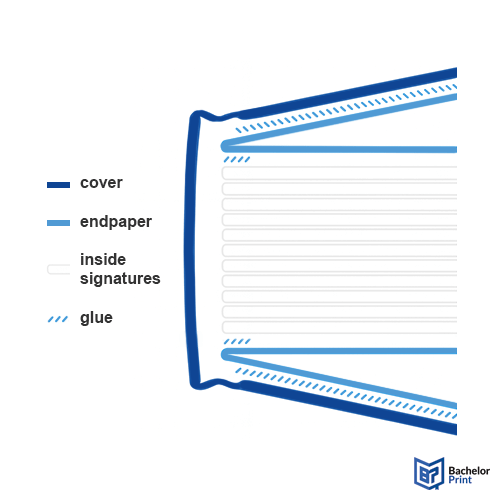
Tipped endpapers
“Tipped in” or “tipped on” basically means “added” onto the book block with bookbinding glue. This is a standard method in case bindings, especially in mass-produced books, because it’s simple and fast.
Here, the paper is folded and scored with a folding bone and glued (tipped) onto the first and last leaves of the book block. Only a narrow strip along the fold is adhered, leaving the rest of the sheet free. The outer half of the endpaper is later glued to the inside of the cover (case).
Due to this method being used in mass production, it is a rather weak endpaper. To improve this weakness, a strip of cloth can be wrapped around the spine fold so it doesn’t tear, and for additional strength, it can be sewn along the sections.
Zigzag endpaper
In 1901, the zigzag endpaper was popularized by bookbinder and author Douglas Cockerell. It consists of three folios folded and arranged in a zigzag (accordion) pattern to create a flexible structure. Folios A and B are tipped together before one side of A (gray) is folded around folio B (blue), creating a waste sheet.
The waste sheet of folio A is then folded again, forming a zigzag. The third folio (light blue) is then placed between the “waste sheet” and folio B before folio C is sewn with the text block. The same thing is done on the other side of the book, just mirrored. This style of endpaper adds strength and allows for easy opening and closing of the book.
If you want to try out this endpaper method, check out this article by Darryn Schneider.
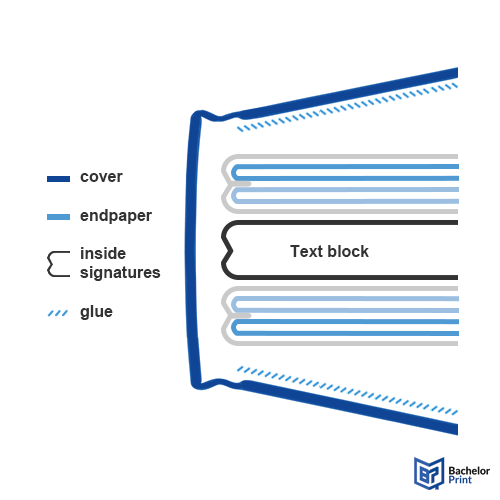
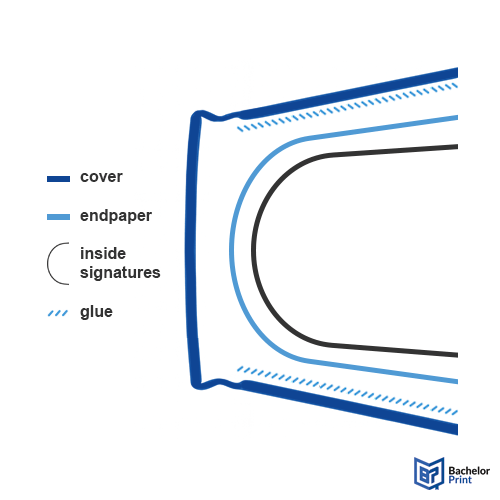
Hooked endpapers
A hooked endpaper is a rare type of endpaper that is used in single-signature books, as it’s a combination of saddle-stitched binding and hardcover binding. In this structure, the endpaper is a folio that is hooked around the outside of the book block, meaning it wraps around the folded content like a cover.
The entire unit — including the hooked endpaper — is then bound together using staples (saddle stitch binding) through the fold. After binding, the outer leaves of the endpaper are glued to the inside of the front and back covers. It can be seen in small booklets and limited editions.
Own paper endpapers
Own paper refers to endpapers that are made from the same printer paper as the book’s text block, rather than using specially chosen sheets. This type is usually found in thinner publications, e.g., like the 2-page endpaper we mentioned before.

Oftentimes, decorative papers are single-sided and thin; that’s where made pages come in. A made page is a laminated page that matches the book block and is adhered to the plain side of the decorative paper. This structure can then be sewn to the book block through the folios.
Since the thickness of the endpaper makes it rather stiff, you can — as an alternative —just laminate a wide tip of the made page before adhering it to the decorative paper. This flexible endpaper makes it easier to flip through the pages, while it’s barely noticeable that the two leaves aren’t fully laminated.
Paste paper is a type of hand-decorated paper created by applying colored starch paste to the surface of plain paper and manipulating it to create unique patterns. This method, frequently used in Germany, is one of the oldest forms of decorative paper and can be found in books that are many centuries old. If you’d like to try it out yourself, refer to this article.
For the pull-paper alternative, you brush the paste onto one side of two sheets of paper before you press them together with the pasted sides facing each other. Once you pull it apart, the separation creates organic, wavy patterns on both sheets. The papers were then hung to dry and glazed with a hot iron to create a smoother surface. This technique dates back to at least the 1700s in Germany.
Printing and laminating at BachelorPrint
- Vivid colors & sharp details on premium materials
- Print & laminate menus, posters, certificates & more
- Durable lamination to protect your documents of any size
Learn more!
Material
For the endpaper, it’s essential that the paper weight is greater than the text block and that the paper’s grain direction matches the orientation of the book spine. Popular paper types are:
- Lokta paper
- Vellum paper
- Marble paper
- Printed paper
- Scrapbook paper
Basically, you can use any printer paper type, and if it’s too lightweight, laminate it to add some heaviness.
FAQs
You can use a variety of papers. Generally, you have to make sure that your endpaper is heavier than your text paper. Paper examples are:
- Lokta paper
- Marble paper
- Decorative papers
Structurally, they help attach the book block to the cover. Aesthetically, they can enhance the design of the book by using decorative or coloured paper.
Paperback books typically don’t have endpapers due to their binding techniques and lightness of written content.
An endpaper refers to the entire sheet or multiple sheets that form the first and last pages of a book. A flyleaf is one part of that structure since it’s the loose (unattached) page that comes right after the cover and before the main content.